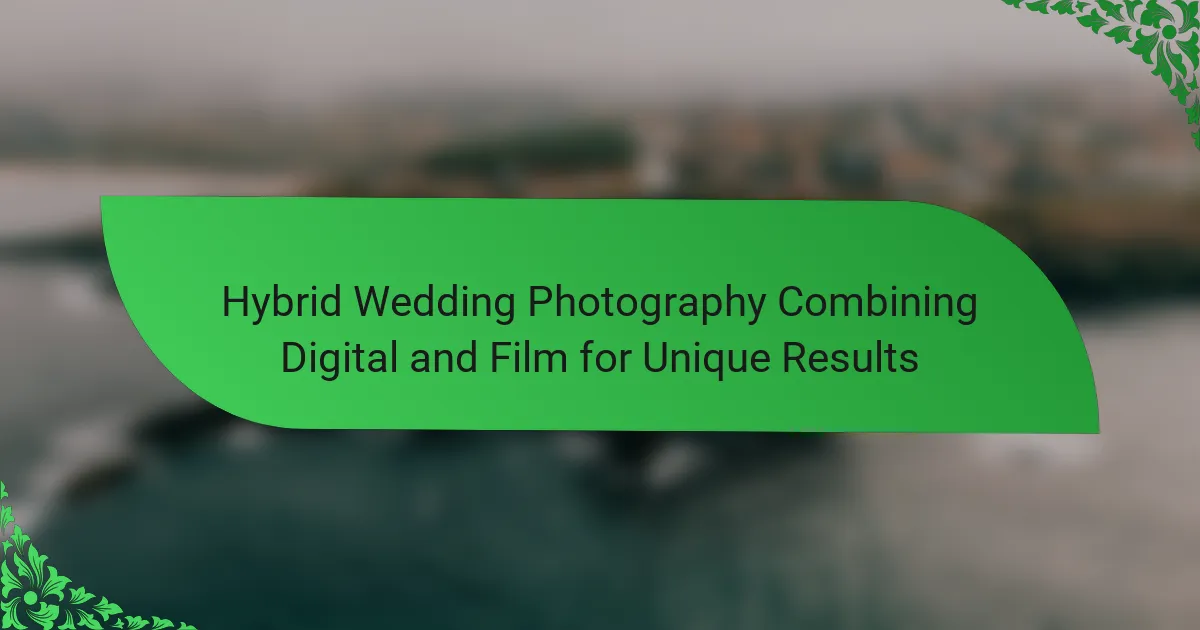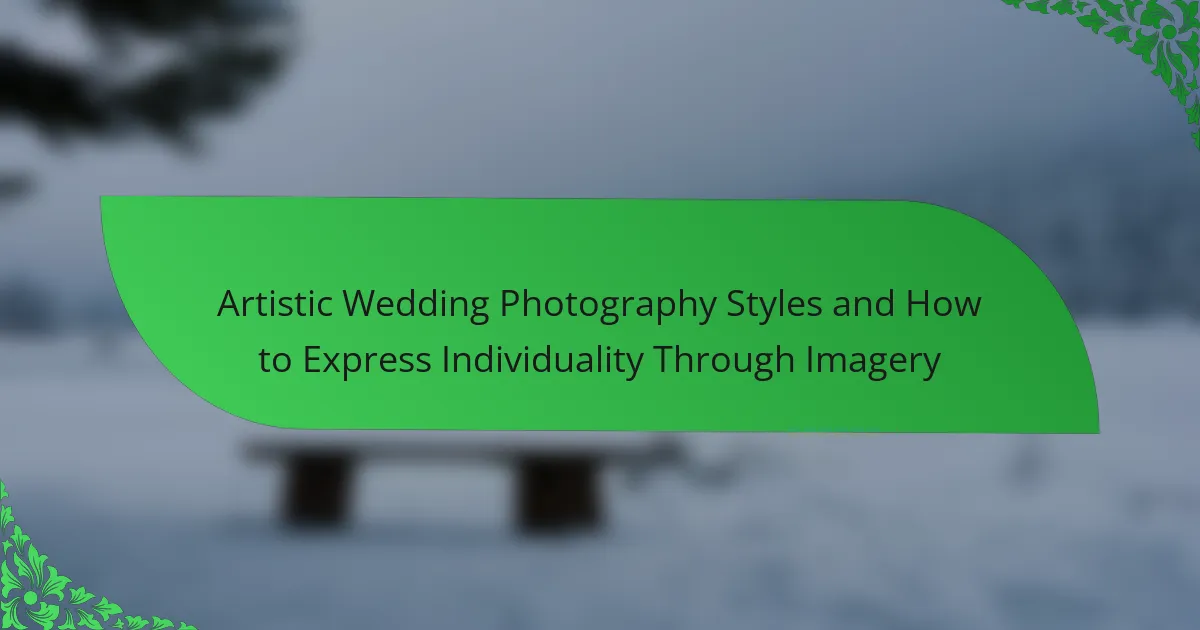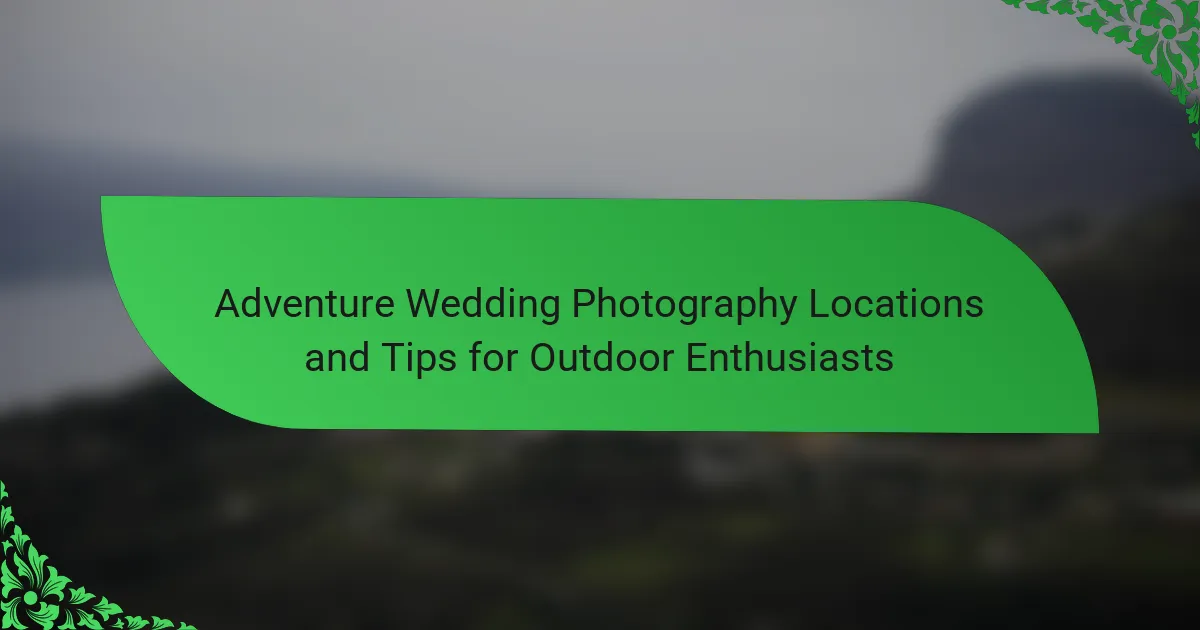Hybrid wedding photography is a technique that integrates both digital and film photography, allowing photographers to leverage the strengths of each medium. This style enhances the storytelling aspect of wedding imagery by capturing spontaneous moments digitally while providing the timeless quality of film. Photographers can create diverse portfolios, utilizing various styles and compositions to meet couples’ aesthetic preferences. Couples considering hybrid photography should evaluate the photographer’s experience with both formats, review their portfolio, and discuss equipment, editing processes, and pricing to ensure a cohesive vision for their wedding day.
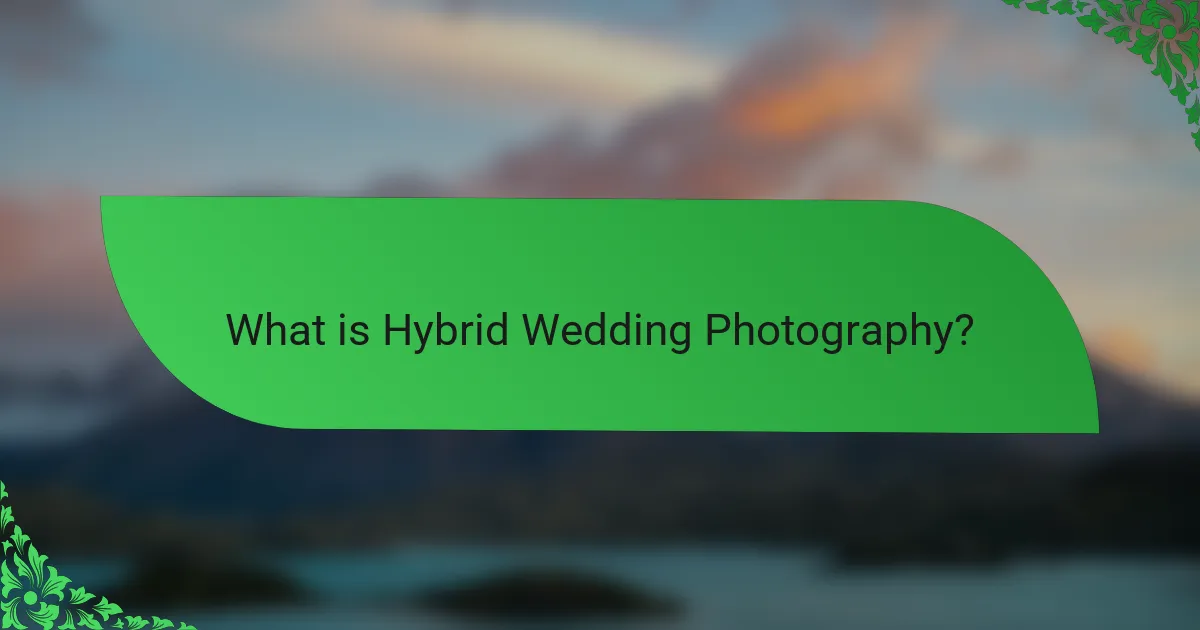
What is Hybrid Wedding Photography?
Hybrid wedding photography is a style that combines both digital and film photography techniques. This approach allows photographers to capture the best of both mediums. Digital photography offers immediacy and convenience, while film provides a unique aesthetic quality. Many photographers choose hybrid methods to create a diverse portfolio. This combination can enhance the storytelling aspect of wedding photography. It caters to different preferences of couples regarding image style. The use of both formats can result in a richer visual narrative. Hybrid wedding photography is increasingly popular among modern couples seeking distinctive imagery.
How does Hybrid Wedding Photography combine digital and film techniques?
Hybrid wedding photography combines digital and film techniques by utilizing both mediums to capture different aesthetic qualities. Digital photography offers immediate feedback and the ability to shoot in varied lighting conditions. Film photography provides a distinct texture and color rendition that many photographers find appealing.
Photographers often shoot key moments on digital cameras for efficiency. They may select specific scenes or portraits to capture on film for a more artistic approach. This method allows for a blend of contemporary and classic styles.
The combination results in a diverse range of images. It provides couples with a unique visual narrative that showcases both modern clarity and vintage charm. Many photographers have reported increased client satisfaction when using this hybrid approach.
What are the key characteristics of digital photography in this context?
Digital photography is characterized by its use of electronic sensors to capture images. This method allows for immediate viewing and editing of photos. Digital images can be easily stored, shared, and printed. High resolution is a common attribute, often exceeding 20 megapixels in modern cameras. Additionally, digital photography offers flexibility in settings like exposure and ISO. The ability to shoot in various formats, such as RAW, enhances post-processing options. Digital cameras typically feature automatic settings for ease of use. Lastly, the integration with software for editing and organizing is a significant advantage.
What are the unique attributes of film photography used in hybrid approaches?
Film photography in hybrid approaches offers unique attributes such as grain structure, dynamic range, and color rendition. The grain structure of film provides a distinct texture that is often sought after for its aesthetic appeal. This texture can enhance the emotional quality of wedding images. Film also has a wide dynamic range. This allows it to capture detail in both highlights and shadows more effectively than some digital sensors. Additionally, film photography is known for its unique color rendition. The colors often appear more saturated and organic compared to digital counterparts. These attributes contribute to a nostalgic and timeless feel in hybrid wedding photography. They create images that resonate with authenticity and artistic value.
Why choose Hybrid Wedding Photography over traditional methods?
Hybrid wedding photography offers a blend of digital and film techniques, providing unique results. This approach captures the best of both worlds. Digital photography allows for immediate feedback and high-resolution images. Film photography adds a timeless, artistic quality to the photos. Couples can enjoy a diverse range of styles and aesthetics. According to a survey by The Knot, 45% of couples prefer a mix of styles for their wedding photography. This trend highlights the growing demand for hybrid methods. Additionally, hybrid photography can enhance storytelling through varied textures and colors. Overall, hybrid wedding photography delivers a more personalized and memorable experience.
What advantages does the hybrid approach offer to couples?
The hybrid approach offers couples the advantage of combining the best of both digital and film photography. This method captures the vibrant colors and sharp details of digital images. Additionally, it incorporates the timeless aesthetic and unique grain of film photography. Couples can enjoy a diverse range of images that reflect their style. The hybrid method also provides flexibility in various lighting conditions. It enables photographers to adapt and choose the best medium for each moment. This results in a richer visual narrative of the wedding day. Ultimately, couples receive a more comprehensive and artistic representation of their special day.
How does it enhance the storytelling aspect of wedding photography?
Hybrid wedding photography enhances the storytelling aspect by combining the strengths of both digital and film formats. Digital photography offers immediate feedback and high-resolution images, capturing fleeting moments with precision. Film photography adds a timeless quality and unique texture, evoking emotions that resonate deeply. Together, they create a rich narrative that reflects the couple’s journey. The contrast between the sharpness of digital and the softness of film can highlight different moods and moments. This blend allows photographers to curate a diverse collection of images that tell a comprehensive story. Studies show that varied visual styles can engage viewers more effectively, making the experience memorable.
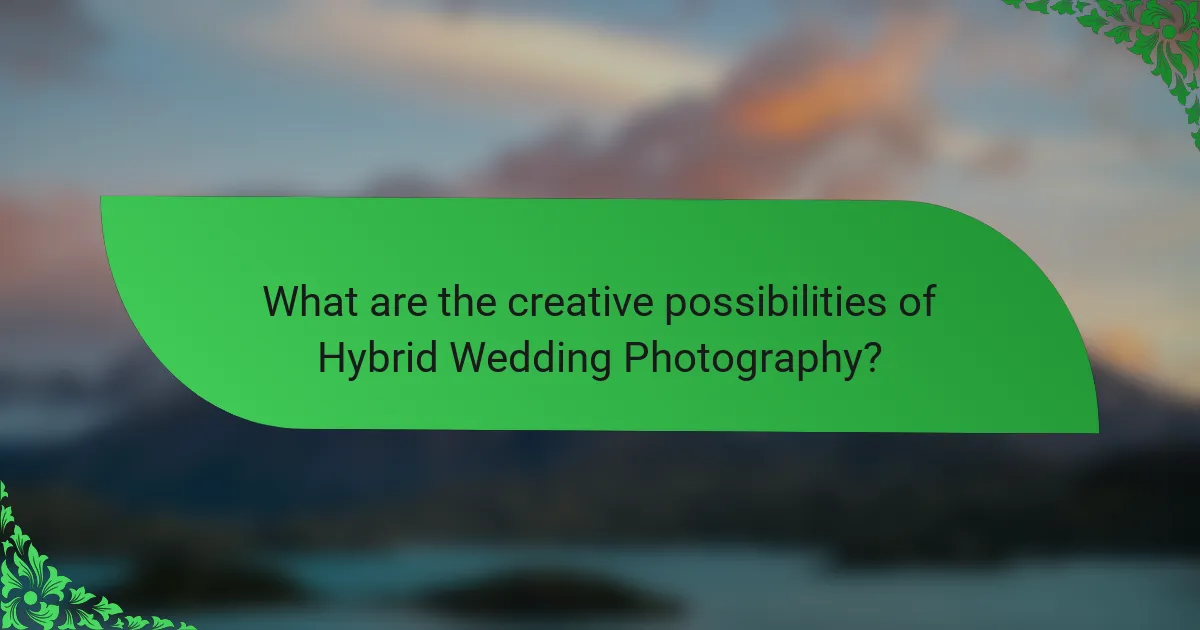
What are the creative possibilities of Hybrid Wedding Photography?
Hybrid wedding photography combines digital and film techniques to create unique visual narratives. This approach allows photographers to capture the spontaneity of digital alongside the timeless quality of film. Photographers can experiment with various styles, such as candid shots with digital and posed portraits on film. The use of film adds a distinct texture and color palette, enhancing the overall aesthetic. Additionally, hybrid photography enables creative storytelling through diverse compositions. It allows for greater flexibility in post-processing, blending the best of both mediums. The combination can evoke nostalgia while maintaining modern relevance. Ultimately, hybrid wedding photography opens up endless creative possibilities for capturing memorable moments.
How can photographers leverage digital and film to create unique results?
Photographers can leverage digital and film by combining their distinct qualities to achieve unique results. Digital photography offers immediate feedback and the ability to shoot in various lighting conditions. This allows photographers to capture moments quickly and adjust settings on the fly. Film photography, on the other hand, provides a rich, organic texture and color depth that is often sought after for its aesthetic appeal. The grain of film can add character to images, creating a nostalgic feel that digital often lacks.
By using both mediums, photographers can create a diverse portfolio that showcases both sharp, vibrant digital images and soft, atmospheric film shots. This hybrid approach allows for creative flexibility, enabling photographers to select the best medium for each moment or scene. For instance, capturing candid moments digitally while using film for posed portraits can yield striking contrasts in style.
This technique has been embraced by many professionals, as evidenced by the growing popularity of hybrid photography in wedding and portrait sessions. Photographers report that clients appreciate the unique blend of styles, which enhances the storytelling aspect of their work.
What techniques are used to blend digital and film images effectively?
Techniques to blend digital and film images effectively include color grading, exposure matching, and texture integration. Color grading involves adjusting the color tones in both media to achieve a cohesive look. Exposure matching ensures that the brightness levels of digital and film images are similar, creating a seamless transition. Texture integration combines the unique grain of film with the sharpness of digital images. Layering techniques can also be used, where digital images are overlaid with film textures to enhance visual depth. These methods ensure a harmonious blend that retains the essence of both formats in hybrid photography.
How does the choice of film type impact the final outcome?
The choice of film type significantly impacts the final outcome of hybrid wedding photography. Different film types offer distinct color renditions, grain structures, and dynamic ranges. For instance, color negative film typically provides a softer look with smooth skin tones. In contrast, slide film delivers vibrant colors and higher contrast, which can enhance specific scenes.
Additionally, the sensitivity of the film type affects exposure latitude. Higher ISO films perform better in low light but may introduce more grain. Conversely, lower ISO films yield finer details but require more light. The choice also influences post-processing capabilities. Some films respond better to certain chemicals during development, affecting the final aesthetic.
Ultimately, the selected film type shapes the emotional tone and visual storytelling of the wedding photography. This variation can create a unique blend when combined with digital images, enriching the overall narrative.
What types of weddings benefit most from Hybrid Wedding Photography?
Hybrid wedding photography benefits most from outdoor weddings, destination weddings, and intimate ceremonies. Outdoor weddings allow for natural lighting, enhancing the film’s aesthetic. Destination weddings often feature unique locations, making the combination of digital and film capture valuable for diverse settings. Intimate ceremonies, with fewer guests, enable more personal shots that film can beautifully capture. These types of weddings leverage the strengths of both mediums. The texture and depth of film complement the clarity of digital photography, creating a rich visual narrative.
Are there specific themes or styles that align well with this approach?
Yes, specific themes and styles align well with hybrid wedding photography. Vintage and rustic themes complement the film aspect effectively. They enhance the nostalgic feel that film provides. Modern and minimalist styles also work well. They allow digital photography to shine through clean lines and simplicity. Fusion styles that blend different cultural elements can benefit from both mediums. Combining film’s warmth with digital’s clarity creates a unique visual narrative. Each theme’s aesthetic can be amplified through the hybrid approach. This results in a more personalized and memorable wedding photography experience.
How do different venues influence the choice of hybrid techniques?
Different venues significantly influence the choice of hybrid techniques in wedding photography. Outdoor venues often provide natural lighting, making film techniques more appealing. This is because film can capture soft, organic hues that enhance outdoor scenery. Conversely, indoor venues may require digital techniques due to lower light conditions. Digital cameras excel in low-light environments, ensuring clarity and detail.
Venue size also plays a role. Larger venues may benefit from digital techniques to capture wide-angle shots. In contrast, intimate venues might allow for film techniques that focus on fine details and emotions. The overall aesthetic of the venue can dictate the photographer’s approach. Rustic venues may align better with film for a vintage feel, while modern venues might suit digital for a sleek look.
Ultimately, the choice of hybrid techniques is tailored to the venue’s characteristics, ensuring the final images reflect the wedding’s atmosphere.
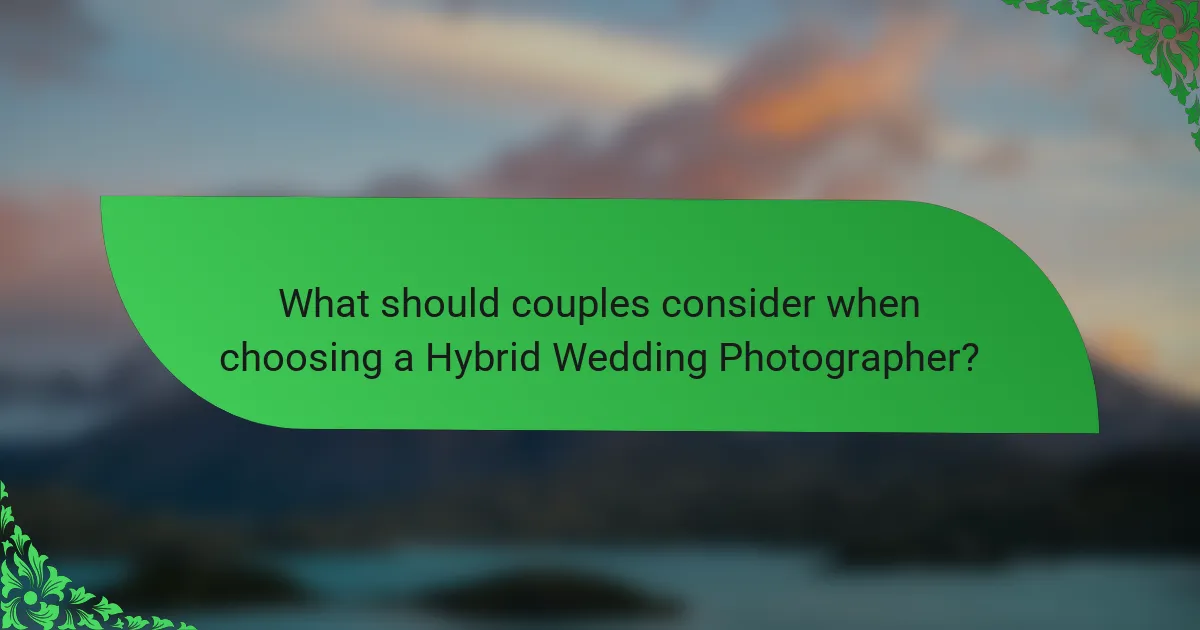
What should couples consider when choosing a Hybrid Wedding Photographer?
Couples should consider the photographer’s experience with both digital and film formats. Hybrid wedding photographers must have a solid understanding of how to blend these two styles effectively. It’s essential to review their portfolio to see examples of their work. Couples should also inquire about the equipment used for both formats. Understanding the photographer’s editing process is crucial for achieving cohesive results. Communication is key; couples should ensure the photographer understands their vision. Additionally, discussing pricing and packages is important to stay within budget. Lastly, reading reviews and testimonials can provide insights into the photographer’s reliability and professionalism.
What questions should couples ask potential photographers about their hybrid process?
Couples should ask potential photographers about their hybrid process to ensure compatibility. Key questions include:
1. What is your experience with hybrid photography techniques? This assesses their expertise in combining digital and film formats.
2. Can you show examples of your hybrid work? Reviewing past projects helps gauge their style and quality.
3. What is your approach to lighting and settings for both formats? Understanding their technique provides insight into how they adapt.
4. How do you handle film development and scanning? This clarifies their process for integrating film into the overall workflow.
5. What equipment do you use for hybrid photography? Knowing their tools helps couples understand the technical aspects.
6. How do you ensure consistency between digital and film images? This question addresses the visual coherence of the final product.
7. What is your timeline for delivering the final images? Timelines can vary significantly based on the hybrid process.
8. Are there any additional costs associated with using film? Understanding potential expenses ensures transparency in pricing.
How can couples assess a photographer’s experience with both digital and film?
Couples can assess a photographer’s experience with both digital and film by reviewing their portfolio. A diverse portfolio should showcase both types of photography. Look for clear examples of film work alongside digital images. Check for consistency in quality across both formats. Ask the photographer about their training and background in each medium. Inquire about the specific equipment they use for film and digital photography. Read client testimonials that mention experiences with both formats. A photographer with extensive experience will be able to discuss the advantages and challenges of each medium.
What portfolios should couples review to evaluate hybrid work?
Couples should review portfolios that showcase both digital and film photography. These portfolios should demonstrate a blend of styles and techniques. Couples can evaluate the consistency in quality across various lighting conditions. They should look for examples of candid moments captured with both mediums. Additionally, the portfolios should highlight the photographer’s ability to tell a story through images. Couples can assess the emotional impact of the photographs presented. It’s also beneficial to examine the variety of compositions used in different settings. Reviewing testimonials from previous clients can provide insight into the photographer’s experience with hybrid work.
What practical tips can enhance the experience of Hybrid Wedding Photography?
To enhance the experience of Hybrid Wedding Photography, couples should communicate their vision clearly with the photographer. Discuss specific moments and styles desired during the shoot. This ensures alignment between expectations and results. Additionally, selecting locations with varied lighting can improve the quality of both digital and film images. Different settings allow for diverse compositions and moods.
Incorporating a timeline for the day helps manage the flow of photography sessions. It ensures that both candid and posed shots are captured without feeling rushed. It’s also beneficial to have a mix of formal and informal shots to provide a comprehensive narrative of the event.
Using props can add personal touches to the photographs. Items like family heirlooms or themed decorations can create unique visual stories. Lastly, considering a second shooter can provide additional angles and perspectives, enriching the overall collection of images. These practical tips can significantly enhance the experience and outcome of Hybrid Wedding Photography.
How can couples prepare for a successful hybrid photography session?
Couples can prepare for a successful hybrid photography session by communicating their vision with the photographer. Discussing preferred styles and specific shots ensures alignment. Selecting a comfortable location enhances natural interactions. Choosing outfits that complement the setting adds visual appeal. Planning the timing of the session helps capture optimal lighting. Including personal props can add unique elements to the photos. Finally, being open to spontaneity allows for authentic moments. These preparations contribute to a cohesive and enjoyable experience, resulting in memorable photographs that blend both digital and film techniques.
What common challenges might arise, and how can they be addressed?
Common challenges in hybrid wedding photography include managing different exposure settings, color grading discrepancies, and equipment compatibility. Exposure settings vary significantly between digital and film, requiring photographers to adjust their techniques. To address this, photographers should practice with both mediums beforehand to ensure consistency. Color grading can also pose a challenge, as film and digital images may not match in tone. This can be mitigated by using consistent lighting and post-processing techniques. Equipment compatibility issues may arise, particularly when using various lenses or cameras. Photographers can solve this by standardizing their gear to ensure seamless integration. Additionally, time management can be a challenge during the shoot. Creating a detailed timeline can help photographers stay organized and efficient.
Hybrid wedding photography is a style that merges digital and film techniques to create distinctive visual narratives. This approach leverages the immediacy and convenience of digital photography alongside the unique aesthetic qualities of film, resulting in a diverse range of images that enhance storytelling. Key characteristics of both mediums, along with their advantages, are explored, highlighting how they cater to various wedding themes and venues. The article also discusses practical tips for couples and photographers to ensure a successful hybrid photography experience, addressing common challenges and offering insights into the creative possibilities of this method.
